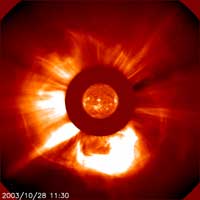
03 November 2003 - Weathering Space
During the past two weeks, the Sun has shown some remarkable activity. There have been no less than 8 major ('X-class') flares, from two large sunspot groups. The fourth of these flares, on 28 October, was the third largest on record (X17), and the fifth on 29 October is in the top 20 (X11). Both of these flung huge amounts of material into space - and they were directed head-on at the Earth, causing widespread aurorae on Wednesday and Thursday nights last week. SOHO/EIT, SOHO/LASCO (ESA & NASA)
During the past few hours, the Sun has emitted three further X-class flares, the first at around 17.25 Sunday night (X8), the second at at about 01.00 (X3) and the third at about 09. 00 (X4) on Monday morning. While these events were not directly aimed at Earth, a radiation storm is in progress again, with consequences as mentioned below, and the Earth may receive a glancing blow from the plasma clouds, with possible aurorae on 3 or 4 November.
Both last week's head-on large events include clouds of hot gas, or plasma from the Sun's atmosphere. They both travelled at over 7 million km per hour - more than 5 times faster than the normal solar wind. When events like this reach Earth, the effects depend critically on the direction of the magnetic field that they carry: if this is North, like the Earth's, our magnetic shield compresses but little else happens. If the field is South, opposite to ours, then our magnetic shield is punctured in places by magnetic reconnection, and particles can penetrate.
The particles that get inside the shield cause enhanced aurora at lower latitudes than usual, and can also cause problems for satellites, aircraft and ground systems. This week's events are unusual in that the major events were separated by less than a day and a half - almost unheard of at this declining time in the Sun's 11-year activity cycle.
MSSL scientists are studying the science behind space weather using space missions like SOHO and Cluster. Both saw all the events. They are also studying the processes which accelerate particles in the magnetosphere, and the effects on technological systems such as satellites and aircraft. They are involved in projects including Mars Express/Beagle 2 and Cassini-Huygens, on the way to Mars and Saturn respectively, both of which have weathered the events. The last week's events will be a challenge to understand as the events followed so rapidly, but we have some exciting data to try and do this.
Space weather has four timescales. First, the X-rays, light and radio waves from the initial event travelling at the speed of light reach us in 8 minutes. Second, high speed protons from the most dangerous flares like these, travelling at less than the speed of light, reach us in 20 minutes to an hour causing a 'radiation storm'. These can upset satellite electronics, degrade solar cells and cause a hazard to humans in spacecraft or aircraft. Third, the clouds of hot gas, called coronal mass ejections, take up to 48 hours to reach Earth: this week's were so fast they reached us in 20 hours. Fourth, if the field is South, particles can be let into the magnetosphere and be accelerated to become 'killer' electrons 1-2 days after the event arrives.
While the two large sunspot groups causing all this activity are about to rotate away from our view to cause a lull in their immediate effects, scientists will again be looking at these unusually active solar blemishes as they come into view again in 2 weeks time, half a solar rotation away.
• Further Information
MSSL's Space Plasma Physics group
MSSL's Solar and Stellar Physics group
Cluster data during last week's events
General news on auroras etc: www.spaceweather.com
